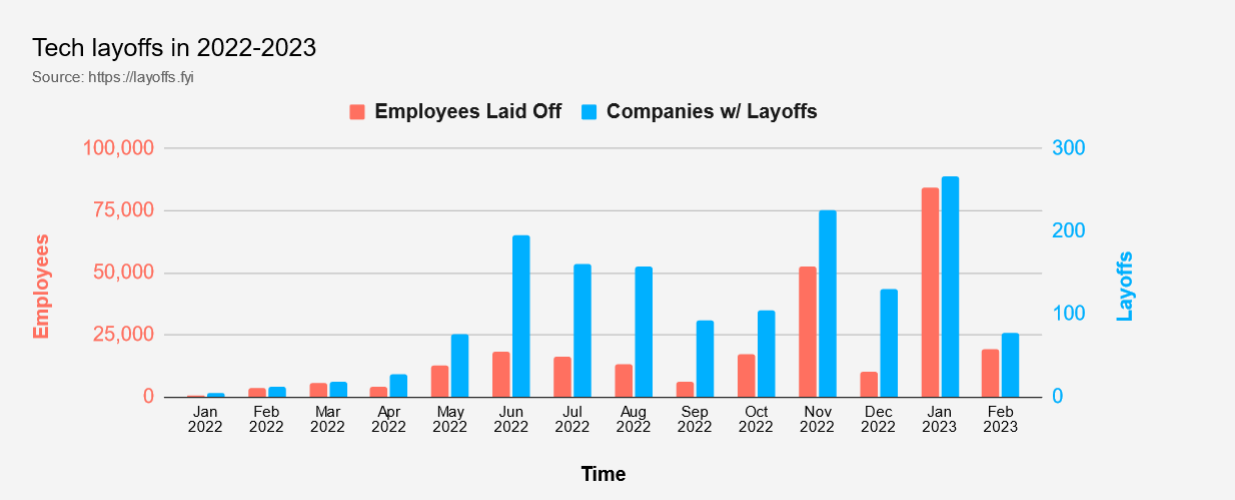
Understanding The Layoff Era Of Big Tech In 2023
“359 tech companies have laid off nearly 105010 employees so far in 2023.“
The world of big tech is undergoing a massive transformation which is why this number of tech layoffs may have already increased as you read this article. With new technologies emerging daily and market trends shifting, businesses are forced to adapt or face the harsh reality of layoffs.
The layoff era has taken hold from Silicon Valley to New York City, leaving many employees uncertain about their futures. But what’s causing this wave of tech layoffs? Is this a natural progression of the technology industry, or is something more sinister at work?
In this blog, we’ll explore the tech layoffs era in 2023, looking at the reasons behind the job cuts, the impact on the industry, and what the Future may hold for tech workers. This blog is for you if you’re an experienced tech professional or just curious about the industry. So, buckle up and prepare to be immersed in the fascinating world of big tech in 2023.
What are the Reasons Behind the Tech Layoffs?
The causes of the layoffs in big tech can be attributed to several factors. Here are some of the most significant reasons behind the job cuts:
Changing Market Trends:
The tech industry is notoriously fast-paced, with innovations and technologies constantly emerging. Companies that fail to adapt to these variations can quickly fall behind their competitors. Companies must be willing to make tough decisions, including cutting jobs and refocusing their resources to stay ahead of the game.
Shifting Consumer Behavior:
Consumer behavior has changed dramatically recently, with people increasingly turning to digital products and services. This has led to an oversaturation of certain markets, with too many players competing for a limited customer base. Companies must be agile and responsive to these changes in order to stay relevant, which often means cutting jobs that are no longer necessary.
Impact of New Technologies:
The growth of artificial intelligence (AI), machine learning, and other disruptive technologies have had a significant impact on the tech industry. While these technologies can help streamline processes and increase efficiency, they can also make certain jobs redundant. For example, chatbots and other automated systems can replace customer service representatives, leading to job cuts.
Globalization and Competition:
The tech industry has become increasingly global, with companies operating across multiple countries and regions. This has led to increased competition, which puts pressure on companies to cut costs and become more efficient. In some cases, this means cutting jobs or moving operations to countries with lower labor costs.
Overall, the reasons behind the layoff era of big tech in 2023 are complex and multifaceted. Companies must be willing to adapt to changing market trends, embrace new technologies, and remain competitive in an increasingly globalized industry. While job cuts can be difficult and painful for those affected, they are often necessary to stay relevant and profitable in a rapidly evolving industry.
The Impact of Tech Layoffs on The Industry
The tech layoffs affect the industry as a whole, with repercussions that extend far beyond individual companies and workers. Here are some of the ways that the job cuts are affecting the industry:
Effect on Big Tech Companies:
The most obvious impact of the layoffs is on the big tech companies themselves. These companies are cutting jobs as they look to restructure and stay competitive, which can lead to a loss of institutional knowledge and expertise. The companies may also struggle to retain top talent as workers become increasingly wary of job security in the industry.
Ripple Effect on Smaller Tech Companies and Startups:
The tech layoffs can also have a ripple effect on smaller tech companies and startups. These companies may rely on the larger firms for business or funding, so job cuts at the big firms can create a ripple effect that leads to job losses throughout the industry.
Impact on the Workforce:
Tech layoffs also have a substantial impact on the workforce. Workers who are laid off may struggle to find new jobs in the industry, particularly if they have specialized skills or experience. This can lead to increased competition for remaining jobs and lower salaries for those who are still employed.
Possible Long-term Consequences for the Industry:
Tech layoffs may have long-term consequences for the tech industry as a whole. If companies continue to cut jobs and move operations to countries with lower labor costs, this could lead to a brain drain of talented workers from more expensive regions. This could, in turn, lead to a decline in innovation and competitiveness as the industry struggles to retain top talent and develop new technologies.
The job cuts impact individual companies, workers, and the industry as a whole, and it remains to be seen how the industry will adapt and evolve in response to these challenges.

What does the Future Hold?
One possible development in the tech industry is that the focus may shift away from large, monolithic companies toward smaller, more agile firms. These firms may be better equipped to respond to changing market conditions and take benefit of new technologies. Another possibility is that the industry may become more decentralized, with more workers employed as freelancers or contractors rather than full-time employees.
There are several potential solutions for workers impacted by tech layoffs. One option is to consider upskilling or reskilling to stay competitive in the job market. This could involve learning new technologies or developing new skills that are in demand. Another option is to consider transitioning to a different field, such as healthcare or renewable energy, which may offer more job stability.
Upskilling and reskilling will become increasingly important for workers in the tech industry. As technologies evolve and change, workers will have to adapt and learn new skills in order to stay competitive. This could involve taking online courses, attending boot camps, or participating in mentorship programs.
Finally, the role of government and policy in addressing the issues facing the tech industry cannot be understated. Governments can encourage the development of new technologies and industries through funding and support while also ensuring that workers have access to training and education. They can also provide incentives for companies to invest in their workforce and create new jobs, which could help to offset the impact of the tech layoffs.
Wrap Up
In conclusion, the layoff era of big tech in 2023 has resulted in job losses and a shift in the industry’s focus. The impact has been significant, but there are potential solutions for workers and future predictions. Workers can upskill or reskill, and governments can support companies to invest in their workforce and create new jobs.
The industry could decentralize with a shift toward smaller, more agile firms. Despite the challenges, the tech industry has demonstrated resilience in the face of change, and it will most likely remain at the forefront of innovation in the years ahead.
Also Read: Technology Jobs Will Get You Top Dollar